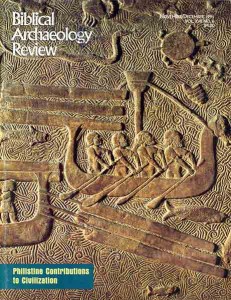Biblical Archaeology Review, November/December 1991
Special Section
Rainey’s Challenge
In a brilliant piece of detective work entitled “3,200-Year-Old Picture of Israelites Found in Egypt,” BAR 16:05, Frank J. Yurco analyzes the reliefs on a wall of the Cour de la Cachette in the Karnak temple in Upper Egypt. But he points to the wrong picture as...Read more ›
Yurco’s Response
Anson Rainey’s article is most welcome. He presents strong support for my overall interpretation of the battle reliefs on the western outer wall of the Cour de la Cachette in the Karnak temple in Egypt. He has interpreted the evidence much as I did, including an overall...Read more ›
From the Press
Our publication of the first fascicle of the secret Dead Sea Scrolls, reconstructed by Professor Ben-Zion Wacholder and Martin Abegg of Hebrew Union College in Cincinnati, received worldwide press coverage. The New York Times and the Washington Post ran their stories on the front page. TV and...Read more ›
Huntington Library Releases Scroll Photographs
As we go to press, the front pages of the New York Times and the Washington Post have announced that the prestigious Huntington Library in San Marino, California, will release photographs of the unpublished Dead Sea Scrolls to all scholars, a step that BAR has been urging...Read more ›
Scholars Exchange–Work in Progress
The Biblical Archaeology Society is establishing a “Scholars Exchange” for “Work In Progress” relating to the Dead Sea Scrolls. If it proves useful, we will consider expanding it to other areas of Biblical studies. Here’s how it works: 1. Any scholar may send us a topic on which he/she is...Read more ›
Team Scholars Working Hard on Dead Sea Scrolls
According to a report issued by the Israel Antiquities Authority, five scholars are now engaged full time in preparing Dead Sea Scrolls for publication. Approximately 30 others are spending part time on the task. “A constant effort is being made to expedite the publication of the scrolls,”...Read more ›
Long-Secret Plates from the Unpublished Corpus
The Biblical Archaeology Society’s publication of transcripts of Dead Sea Scrolls (“BAS Publishes Secret Dead Sea Scrolls,” BAR 17:05) has been almost universally applauded, with one prominent exception—the editors who still control access to the secret documents. According to a headline in the Jerusalem Post they are...Read more ›
Is the Vatican Suppressing the Dead Sea Scrolls?
A book that will soon be available in the United States was recently published in England under the title The Dead Sea Scroll Deception by Michael Baigent and Richard Leigh (Jonathan Cape, 1991).1 The book’s thesis is that the Vatican is suppressing the Dead Sea Scrolls because...Read more ›
Carbon-14 Tests Substantiate Scroll Dates
Carbon-14 (C-14) tests on samples of the Dead Sea Scrolls have substantially confirmed the previous date of the scrolls based on paleography (the shape of the letters), according to two recent reports.1 This general conclusion was announced in a press release some months ago, but when BAR...Read more ›
Features
The Last Days and Hours at Masada
The last stand in the First Jewish Revolt against Rome took place on the nearly diamond-shaped mountaintop of Masada, site of a palace-fortress completed by Herod the Great (37–4 B.C.E.). Jewish Zealots who occupied Masada at the start of the revolt in 66 C.E. held the site...Read more ›
The Sea Peoples and Their Contributions to Civilization
The Sea Peoples are unappreciated. This is in part because the most famous of them, the Philistines, received such bad press in the Bible. But the other Sea Peoples—among them the Shardana, Sikila, Lukka and the Danuna—have also been treated poorly, even by scholars, who often blame...Read more ›
The Philistines Enter Canaan
Were they Egyptian lackeys or invading conquerors?
Archaeology has brought the Philistines to life more vividly than perhaps any other Biblical people save the Israelites and the Egyptians.a We now know that the Philistines were one of the Sea Peoples that also included the Tjeker, the Denyen (or Danuna), the Shardana and the Weshesh...Read more ›

